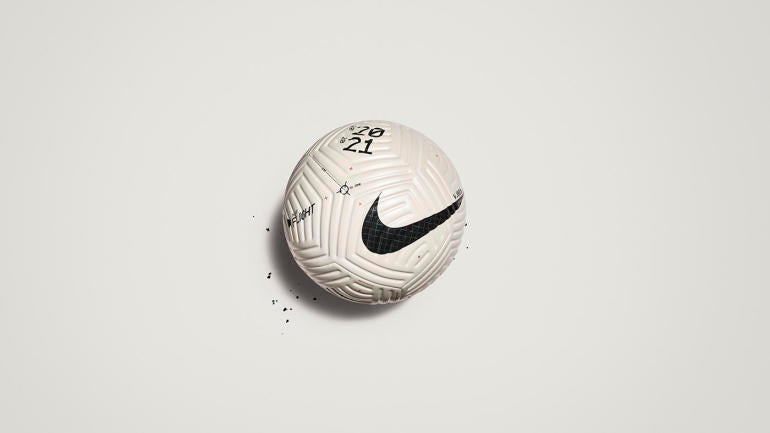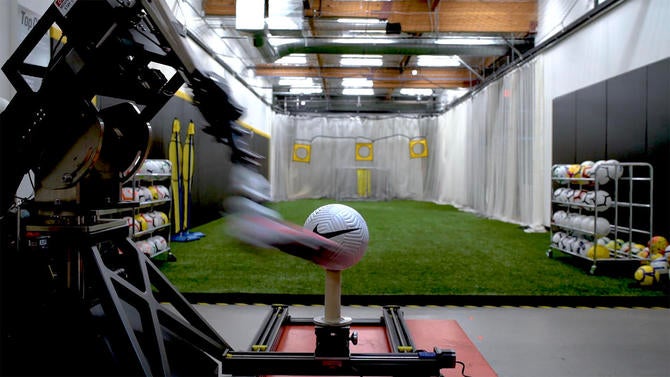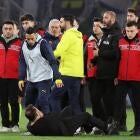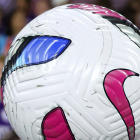
Nike set out on an eight-year mission to create the perfect soccer ball, and players from some of the top leagues in the world will soon play with the latest model of a modern and futuristic ball. It's no secret that soccer players -- and athletes in general -- are pretty sensitive to any changes to their equipment, especially the ball. That's why Nike consulted over 800 professional athletes, including non-Nike sponsored athletes, and spent eight years researching before crafting the Nike Flight ball, unveiled globally on Monday.
The sleek, innovative ball will make its debut next season in the NWSL -- which became the first professional team sports league in the United States to mark its return during the coronavirus pandemic on Saturday -- along with the Premier League, Serie A and the Russian Premier League, among others.
The name of the ball hints at what culminated from nearly a decade of research. The engineering team covered 68 different iterations of the ball and spent 1,700 hours in the lab before settling on a ball that, thanks to its new AerowSculpt technology, can hug the air and produce 30 percent truer flight than previous Nike soccer balls. It specifically exceeds the Nike Merlin, which is used in the Premier League and other major leagues these days.

At first glance, the Nike Flight ball nearly looks like a jumbo-size golf ball, especially once you start paying closer attention to details such as the pentagonal-like dimples or ridges from a 3D ink layout. It's why the sportswear giant opted for a simplistic all-white colorway. Kieran Ronan, who's the senior director for global equipment at Nike, explained how they managed to take innovative learning from other sports industries, including golf, and applying it to their study to help influence the flight of the ball and prevent wobbling.
"There were so many different permutations, but the one thing that was true to the golf ball back then and still is now is its ability to fly through the air. And in golf, you're taking into factor how far the ball is going to travel downwind versus into the wind, whether wind is coming off your left, off your right and so on and so forth -- rain, dry, humidity," Ronan told CBS Sports. "The principles of what that does is, when you think about a smooth surface, when it travels through the air, it is gripped by the air. The application of dimples in this case from the golf ball, or in our case with the AerowSculpt technology, it is distorting the surface so that the air can grip it, which allows basically in essence a truer flight."
Manchester City, Chelsea, Tottenham and the United States women's national team were among the notable teams to work with Ronan over the years. Megan Rapinoe and Alex Morgan both provided feedback during the eight-year project. But it wasn't just star players that helped Ronan and his team design the ball. They took a ton of input from a robotic kicking leg in their lab to help track boot-to-ball tests on the aerodynamics of the ball, which was another tip-of-the-cap to tracking technology used in golf and adopted in baseball.
"The other thing taken from the golf industry is the speed of iterations. When we brought the robot into the lab three or four years ago, that allowed us to up the ante, the amount of testing that we could do," Ronan said. "The 1,700 hours of testing comes from the players, what they're saying, bringing that in and mapping it and plotting it against an equation, feeding that information into the system for the robot, and then the robot starts its job."
But why robots? Consistency.
"If you think about bringing in a player to come in and you were to ask a player to hit a thousand shots, the muscle fatigue, the overall physical fatigue, the information you get from the first kick, or maybe five or six kicks after they're warmed up, all the way to the thousand kick will give you a very, very different set of parameters" Ronan said. "Whereas with the robot, you're working precisely in that range and you can start to work with the depth of the grooves, the shape of the grooves, the overall aesthetic appearance of the design to help get us to the optimal number that we're looking for in this moment and time."

Unlike traditional 12-panel soccer balls, the Nike Flight ball only uses four fuse-wielded panels to help enable a prominent sweet spot for superior touch and performance. USWNT and OL Reign midfielder Ally Long, who is currently participating in the 2020 NWSL Challenge Cup on CBS and CBS All Access, explained the importance of a constant and truer flight to the ball.
"As a central midfielder I want to be on the ball all the time and be the quarterback that can help build the attack by using all different ranges of passes," Long said. "In order for me to be the best, the ball needs to be consistent and predictable. Not too light, not too hard, made with the perfect material so every touch I take can be perfect to set me up for the next pass. There is nothing better when I hit a ball perfectly and it goes exactly where I want it to go."
![[object Object] Logo](https://sportshub.cbsistatic.com/i/2020/04/22/e9ceb731-8b3f-4c60-98fe-090ab66a2997/screen-shot-2020-04-22-at-11-04-56-am.png)

















